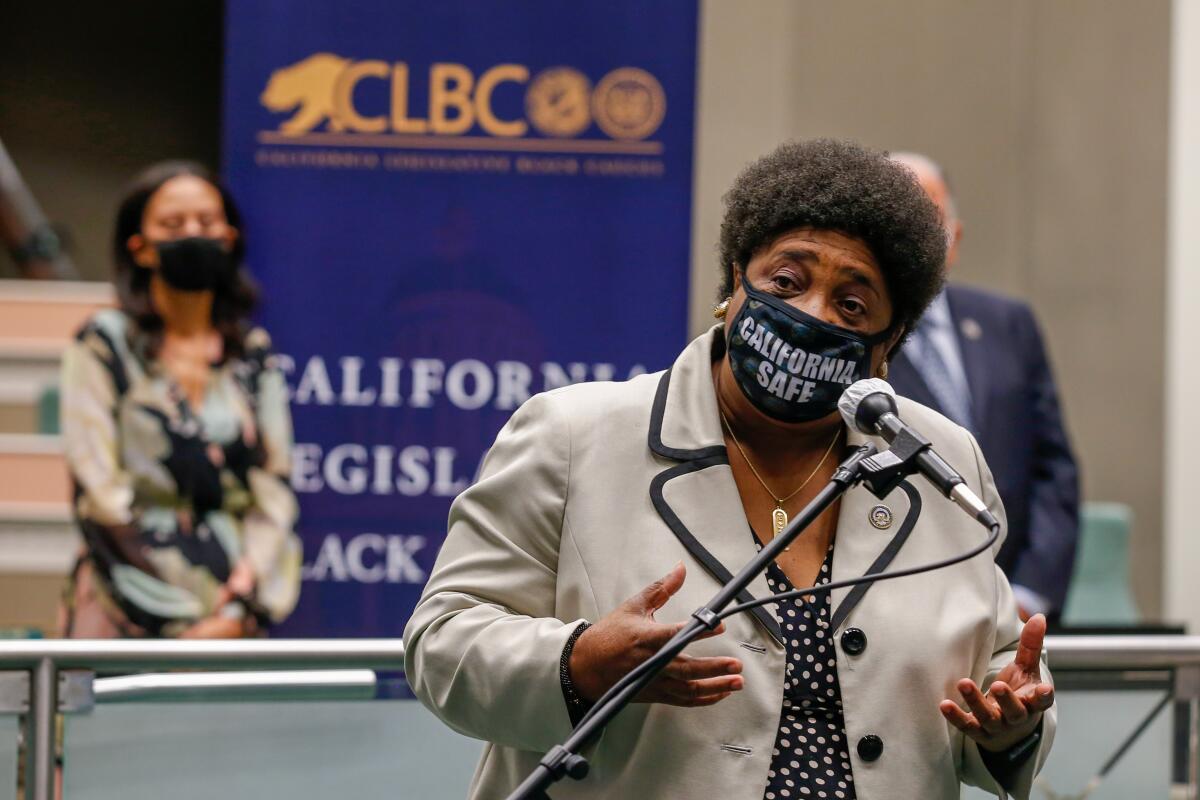Plan to restore affirmative action in California clears hurdle after emotional debate

- Share via
SACRAMENTO — California voters would be asked to erase the state’s 24-year ban on affirmative action in November under a proposal approved Wednesday by the state Assembly, with supporters arguing their effort is more important than ever amid nationwide protests for racial equality and justice.
The plan would strike from California’s Constitution the rules imposed by Proposition 209, which prohibits government agencies and institutions from giving preferential treatment to individuals on the basis of race or sex. The ballot measure sparked a fierce political and cultural debate in 1996, much of which focused on the impact of the era’s affirmative action policies for admission to the state’s colleges and universities.
Although subsequent legal challenges left Proposition 209 on the books, opponents have argued the law has preserved and deepened the inequities in education and government contracting opportunities for a generation of Black and Latino Californians — a reality the bill’s supporters said has never been more clear.
“The ongoing pandemic, as well as recent tragedies of police violence, is forcing Californians to acknowledge the deep-seated inequality and far-reaching institutional failures that show that your race and gender still matter,” said Assemblywoman Shirley Weber (D-San Diego), the author of the bill, Assembly Constitutional Amendment 5.
ACA 5 now moves to the state Senate, where it must be ratified by June 25 in order to be placed on the Nov. 3 statewide ballot.
The lengthy discussion of the proposed ballot measure included only two dissenting voices, both Republican lawmakers.
Irvine Republican Assemblyman Steven Choi said that “giving special or preferential treatment to someone based on their race is racism itself, or on their sex is sexism.”
Assemblyman James Gallagher (R-Yuba City) argued ACA 5 would not end racial discrimination in California’s education system, insisting that ineffective teachers in low-income communities are kept there by tenure rules that are demanded by teachers unions.
“You can talk about admissions and using, bringing back affirmative action, but what are we doing to ensure that Black and brown students graduate and get that education?” Gallagher said. “That’s a conversation that we need to be having. We need to go even deeper.”
But more than two dozen Assembly members who spoke during Wednesday’s debate said the 1996 law is antiquated, as is its promise to voters in the 1996 campaign to help create a “colorblind” society.
“Systematic racism didn’t stop because of [Prop.] 209,” said Assemblywoman Lorena Gonzalez (D-San Diego), who noted she had benefited from affirmative action as a law student in the ‘90s. “And so what we’ve seen over these generations is the missed opportunity of so many kids in our communities who haven’t had the benefit that we all had.”
The overwhelming support for asking voters to reconsider affirmative action stood in stark contrast to 2014, when a similar effort in the state Capitol to send the issue of affirmative action back to voters roiled the Legislature. Several lawmakers at the time abandoned the effort after advocacy groups warned that reinstatement of affirmative action would limit college admissions for Asian American students.
But those old wounds resurfaced late in the debate Wednesday that lasted more than two hours. Assemblyman Evan Low (D-Campbell) said that far more constituents calling his office asked him to vote against ACA 5 than those asking him to support it. He said Chinese Americans, in particular, “believe that if you do the hard work as you’re told, they will have their chance too.”
Others said the topic wasn’t so clear in the Asian American community.
Beneath the fury over George Floyd’s death lie longstanding economic inequities that have plagued California’s 2.6 million black people.
“Some of the opposition want you to believe that Asian Americans unilaterally oppose affirmative action,” Assemblyman David Chiu (D-San Francisco) said during Wednesday’s debate. “That is simply not true. ... I hear all the time that my Asian American constituents want more teachers who look like us, more principals, university presidents, more first responders, firefighters, bilingual police officers. Current law prevents that.”
In 2017, the issue surfaced again when caucuses representing Asian American legislators asked candidates for governor, including Gov. Gavin Newsom, to weigh in on whether race should be used in college and university admissions. Newsom and his Democratic challengers voiced support for affirmative action; the Republican candidates didn’t respond to the question.
Few topics have been more consistently debated in California, where a clash over UC Davis’ affirmative action policy resulted in a landmark 1978 ruling by the U.S. Supreme Court upholding it. By 1995, conservative activists believed the state’s electorate would overturn such policies and drafted a ballot measure to enshrine a ban in the state Constitution.
Proposition 209 barred any attempt to “grant preferential treatment” based on gender or race and passed on Nov. 5, 1996, with support from 55% of voters. Numerous studies have since dissected its impact, and opponents have stood firm that the constitutional amendment has done nothing to limit racial, gender and economic discrimination.
Weber, a Democratic lawmaker who has championed a number of bills she believes would root out systemic inequality, has argued that California was making consistent progress in the early 1990s in helping nonwhite entrepreneurs and businesses owned by women — an upward trajectory, she said, that came to an end with the passage of Proposition 209.
“Removing [Prop.] 209 will not solve all of the problems,” she said on Wednesday. “But it’s one of the many tools that we have to have in California, to say California is the land of great opportunity.”
More to Read
Sign up for Essential California
The most important California stories and recommendations in your inbox every morning.
You may occasionally receive promotional content from the Los Angeles Times.












